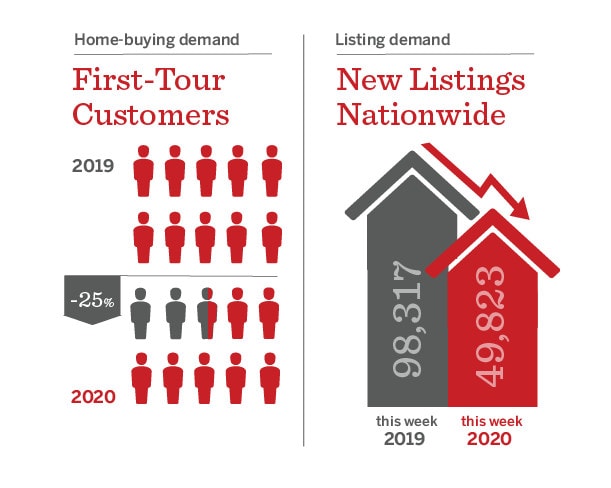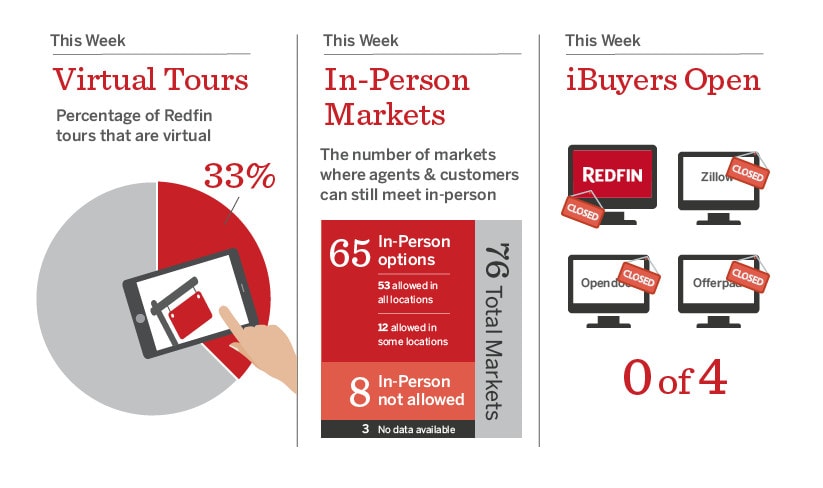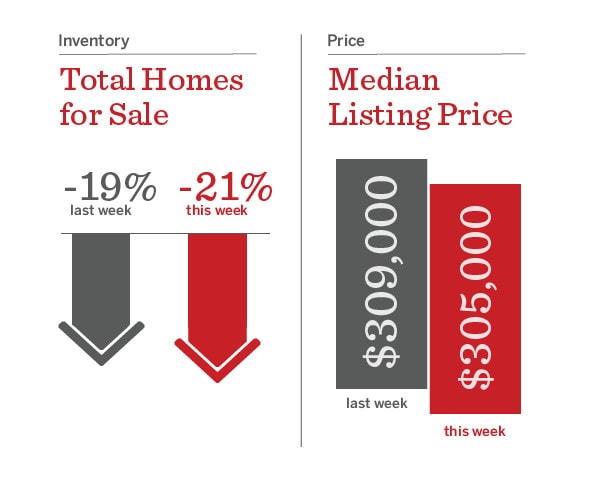Spring started more than three weeks ago, but this week felt more like a new beginning. Home-buying demand, as measured by the annual growth rate in customers going on their first tour with a Redfin agent, took the first few halting steps towards recovery. For the seven days ending April 13, home-buying demand was down 25% compared to the prior year after being down as much as 36% for the seven days ending March 28.
It’s still too soon to say if home-buying demand will suffer a relapse, and the road to a full recovery is long; in January and February Redfin’s home-buying demand was up 27% compared to the prior year.

The improvement in home-buying demand is especially notable because this year Easter fell on April 12, when it landed on April 21 in 2019. Normally home-buying demand is weaker over the holiday weekend, but with gatherings limited by social distancing, it appears people kept shopping for homes.

This past weekend, nearly one-third of Redfin’s home tours were conducted via video chat. Now buyers are writing offers based on those tours. For the week ending April 12, 1 in 8 Redfin offers were written by customers who viewed the home via video chat even though some also saw the home in person.
While the coronavirus outbreak has prompted consumers to change their behavior, it’s a change Redfin agents think is here to stay. Mara Gemond, a Redfin agent in Virginia, has had three buyers who’ve written offers based on a video tour, but none of them were avoiding COVID-19 exposure; all three were moving from at least an hour away. “There are still some kinks to work out,” Mara said. “My kids laugh at me because I have nine different video apps on my phone.”
Last weekend, Redfin also began piloting our Direct Access technology with vacant listings in Denver, Houston and Las Vegas. Direct Access turns Redfin’s mobile application into a key that lets a verified buyer tour a Redfin listing without an agent. Until last weekend, Direct Access was only available on homes Redfin owns through RedfinNow, but demand from buyers and sellers prompted us to roll this technology out to homes listed by Redfin’s agents.

We’re still hearing reports of bidding wars from agents across the country, especially for affordable homes and homes in desirable neighborhoods. Janet Rose, a Redfin agent in Oklahoma, has buyers relocating from the coasts to take advantage of lower prices. “There are Amazon and Dell facilities in the area as well as an Air Force base, so those people have stable jobs and can buy a home around the $200,000 price point.” Oklahoma hasn’t seen as many COVID-19 cases as the rest of the country and real estate is considered an essential service in the state. Janet said, “I feel busy.”
Despite these pockets of activity, U.S. pending sales are down 54% for the seven days ending on April 10 compared to the prior year. As recently as March 10, pending sales were flat compared to the prior year.

Pending sales are declining while home-buyer demand is strengthening because many sellers are sitting on the sidelines. There are currently just over 750,000 homes for sale in the U.S. compared to just under 1 million homes for sale at this time last year.
A 50% decline in pending home sales would normally lead to a drop in prices, but the lack of homes for sale is keeping prices relatively stable. The median listing price fell from $309,000 last week to $305,000 over the seven days ending on April 10. That’s flat with the median listing price at this time last year.
We still haven’t seen an increase in price reductions, but homes are starting to sit on the market just a little longer. Homes on the market have been listed for an average of 64 days, up from a low of 58 days earlier in March. If homes sit longer, we may see prices slide further.

Health concerns, stay-at-home orders, and lenders overwhelmed by refinance applications are slowing down transactions. Irma Jalifi, a Redfin agent in Houston, said, “My clients just accepted an offer with 30 days for the buyers to get their financing approved, when it should take two weeks, or less. I worry the house will be off the market for a month and the deal still won’t come together. In this market you’re damned if you do, damned if you don’t.”
In Pittsburgh, Redfin agent Sara Minshull has a buyer waiting 40 days to do a physical inspection of the property due to the seller’s health concerns. Buyer and seller have agreed to extend the timeline an extra 30 days if the coronavirus isn’t contained by then. A 70-day property inspection is unheard of when the normal turnaround is a few days to a few weeks.
The biggest storm cloud on the real estate horizon is that credit is getting harder to come by. Last week we reported limited availability of both jumbo loans for higher-priced homes and FHA loans targeted at first-time buyers.
This week, lenders raised credit standards even for conforming loans that are guaranteed by Fannie Mae and Freddie Mac. On April 13, JP Morgan Chase announced it will require a 20% down payment and a minimum credit score of 700. With average U.S. credit scores around 700 the changes at Chase could take a big bite out of home-buying demand, especially if other lenders follow suit.
With unemployment claims at almost 17 million and 11% of U.S. workers out of work, it’s not surprising lenders are battening down the hatches. But the biggest threat to the availability of credit comes straight from Washington, D.C., wrapped in good intentions. The CARES Act lets homeowners receive a forbearance on mortgage payments for up to 12 months, without requiring any documentation. Already, nearly 4% of loans are in forbearance, up from 0.25% in March.
The catch is that the banks servicing loans in forbearance still have to front the monthly payments to the investors who purchased those loans. So while the Fed shovels money into the mortgage-backed securities market to keep 30-year mortgage rates below 3.5%, lenders are restricting credit so only borrowers with stable incomes and sterling FICO scores have access to it. Hopefully, Chairman Powell starts directing a portion of the money earmarked to stabilize housing towards mortgage servicers soon.
That’s it for this week. Please stay safe, and if you can, stay home. If you’re out on the front lines, please accept the most sincere thanks from everyone here at Redfin.
Redfin is publishing this housing-market update as a way to inform our customers, not our investors. Even though we’re notifying investors through a government filing about this customer update, we’re not updating, withdrawing, or affirming the first quarter financial guidance we issued on February 12, 2020. Unless otherwise noted, all data in this update is as of April 11, 2020.


